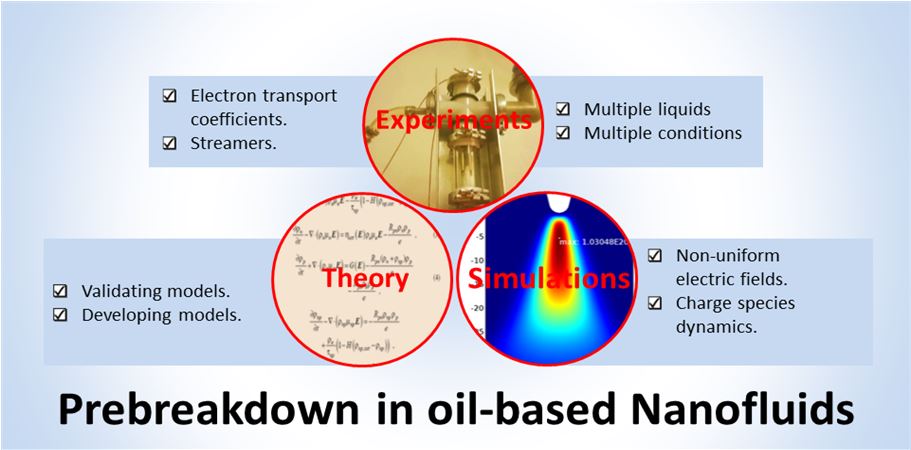Prebreakdown in nanofluids
Project name: On the Mechanisms of Prebreakdown in Mineral oil-based Nanofluids
About the project
Nanoparticles are one of the most important technological developments of this century since their unique properties are revolutionising many different fields of science and technology. Particularly, the field of dielectric liquids can potentially benefit from the use of nanofluids (nanoparticles dispersed in the fluid). From the experimental studies found in the literature very promising results have been obtained: improvement on breakdown strength, delay of aging of mineral oil, improvement on the partial discharge response, enhancement of thermal conductivity, among others positive results.
However, nanofluids in dielectric applications is a nearly unexplored area in nanoparticle research due to the fundamental lack of understanding about the physical mechanisms involved in their improved performance compared with the host fluid. This proposal intends to answer the major basic questions on the effect of nanoparticles on the prebreakdown phenomena in mineral oil-based nanofluids and to validate or refute the existing theories about it. This knowledge is useful in selecting the proper type and concentration of nanoparticles required to reach an optimum dielectric performance and to assess the actual potential of nanofluids as substitute of traditional dielectric hydrocarbon liquids. Moreover, the extensive experimental results from this research project will shed light upon the fundamental electronic processes and on the mechanisms behind the improvement of breakdown strength in nanofluids, which is a first step towards the development of an improved predictive theory to understand the behaviour of nanoparticles in dielectric liquids.
Project description
The aims of this research project are:
- To investigate the fundamental electronic processes in mineral oil-based nanofluids.
- To understand the effects of nanoparticles dispersed in mineral oil on the phenomena leading to dielectric breakdown.
- To adapt existing numerical models to simulate these effects.
The host liquid under study is filtered and degassed mineral oil. The nanoparticles investigated are made of graphene flakes, fullerene, TiO2 (titania), Al2O3 (alumina), ZnO (zinc Oxide), Fe3O4 (magnetite) and SiO2 (silica). The mobility and attachment rate of electrons on nanofluids, and the effects of nanoparticles in the initiation and development of streamers are to be investigated through laboratory experiments. One of the expected outcomes of this project is a numerical model of the streamer inception on nanofluids under non-homogenous electric fields.


Publications
Streamer Inception from Ultra-Sharp Needles in Mineral Oil Based Nanofluids
Electrical conduction currents of a mineral oil-based nanofluid in needle-plane configuration
Simulation of the electrical conduction of cyclohexane with TiO2 nanoparticles
Financial sponsor(s)
The colombian research council (Colciencias).
Project responsible
Personal experience at KTH
KTH is a nice place to build up my academic career. The research group of Applied Physics and Multiphysics Modelling for Power Components is an exciting environment to work in. The talent and experience of its members and the laboratory and computer facilities give me the opportunity to fulfil my PhD and to push forward the knowledge barrier on my research field.